AMD's Radeon HD 6990: The New Single Card King
by Ryan Smith on March 8, 2011 12:01 AM EST- Posted in
- AMD
- Radeon HD 6990
- GPUs
Power, Temperature, and Noise: How Loud Can One Card Get?
Last but not least as always is our look at the power consumption, temperatures, and acoustics of the Radeon HD 6990 series. This is an area where AMD has traditionally had an advantage, as their small die strategy leads to less power hungry and cooler products compared to their direct NVIDIA counterparts. Dual-GPU cards like the 6990 tend to increase the benefits of lower power consumption, but heat and noise are always a wildcard.
AMD continues to use a single reference voltage for their cards, so the voltages we see here represent what we’ll see for all reference 6900 series cards. In this case voltage also plays a big part, as PowerTune’s TDP profile is calibrated around a specific voltage.
| Radeon HD 6900 Series Voltage | ||||
| 6900 Series Idle | 6970 Load | 6990 Load | ||
| 0.9v | 1.175v | 1.12v | ||
The 6990 idles at the same 0.9v as the rest of the 6900 series. At load under default clocks it runs at 1.12v thanks to AMD’s chip binning, and is a big part of why the card uses as little power as it does for its performance. Overclocked to 880MHz however and we see the core voltage go to 1.175v, the same as the 6970. Power consumption and heat generation will shoot up accordingly, exacerbated by the fact that PowerTune is not in use here.

The 6990’s idle power is consistent with the rest of the 6900 series. At 171W it’s at parity with the 6970CF, while we see the advantage of the 6990’s lower idle TDP versus the 5970 in the form of a 9W advantage over the 5970.
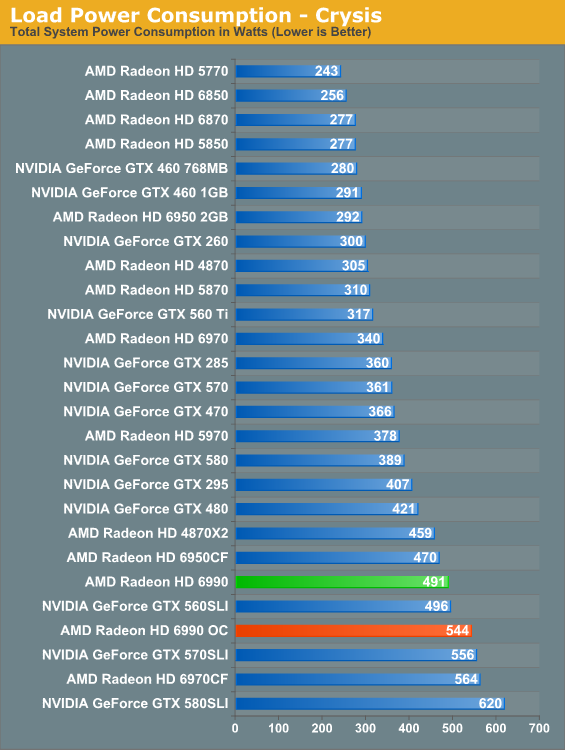
With the 6990, load power under Crysis gives us our first indication that TDP alone can’t be used to predict total power consumption. With a 375W TDP the 6990 should consume less power than 2x200W 6950CF, but in practice the 6950CF setup consumes 21W less. Part of this comes down to the greater CPU load the 6990 can create by allowing for higher framerates, but this doesn’t completely explain the disparity. Compared to the 5970 the 6990 is also much higher than the TDP alone would indicate; the gap of 113W exceeds the 75W TDP difference. Clearly the 6990 truly is a more power hungry card than the 5970.
Meanwhile overclocking does send the power consumption further up, this time to 544W. This is better than the 6970CF at the cost of some performance. Do keep in mind though that at this point we’re dissipating 400W+ off of a single card, which will have repercussions.
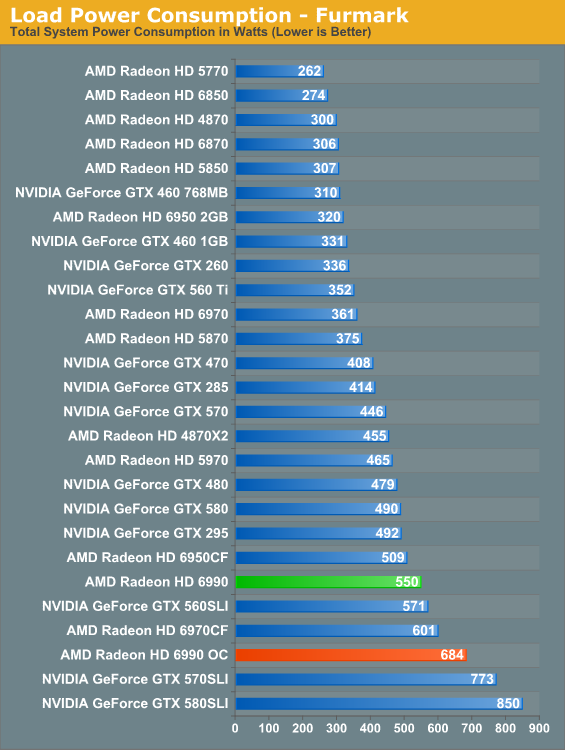
Under FurMark PowerTune limits become the defining factor for the 6900 series. Even with PT triggering on all three 6900 cards, the numbers have the 375W 6990 drawing more than the 2x200W 6950CF, this time by 41W, with the 6970CF in turn drawing 51W more. All things considered the 6990’s power consumption is in line with its performance relative to the other 6900 series cards.
As for our 6990OC, overclocked and without PowerTune we see what the 6990 is really capable of in terms of power consumption and heat. 684W is well above the 6970CF (which has PT intact), and is approaching the 570/580 in SLI. We don’t have the ability to measure the power consumption of solely the video card, but based on our data we’re confident the 6990 is pulling at least 500W – and this is one card with one fan dissipating all of that heat. Front and rear case ventilation starts looking really good at this point.
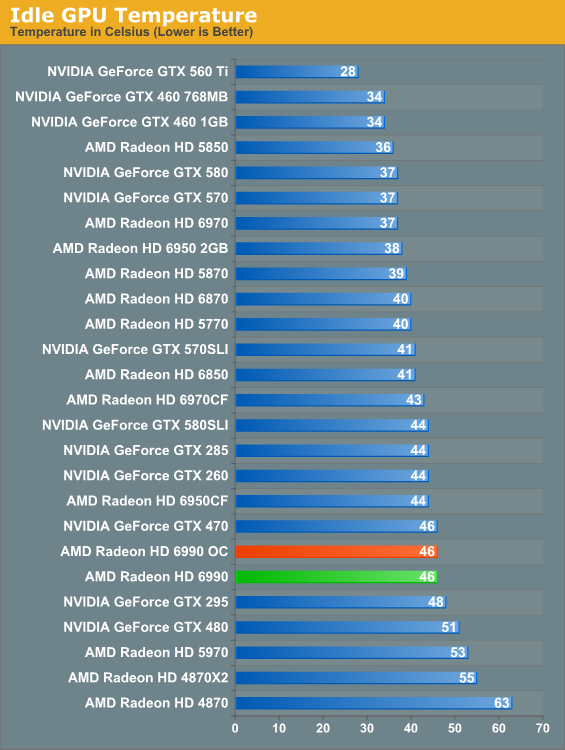
Along with the 6900 series’ improved idle TDP, AMD’s dual-exhaust cooler makes its mark on idle temperatures versus the 5970. At 46C the 6990 is warmer than our average card but not excessively so, and in the meantime it’s 7C cooler than the 5970 which has to contend with GPU2 being cooled with already heated air. A pair of 6900 cards in CF though is still going to beat the dual-exhaust cooler.

When the 5970 came out it was warmer than the 5870CF; the 6990 reverses this trend. At stock clocks the 6990 is a small but measurable 2C cooler than the 6970CF, which as a reminder we run in a “bad” CF configuration by having the cards directly next to each other. There is a noise tradeoff to discuss, but as far as temperatures are concerned these are perfectly reasonable. Even the 6990OC is only 2C warmer.
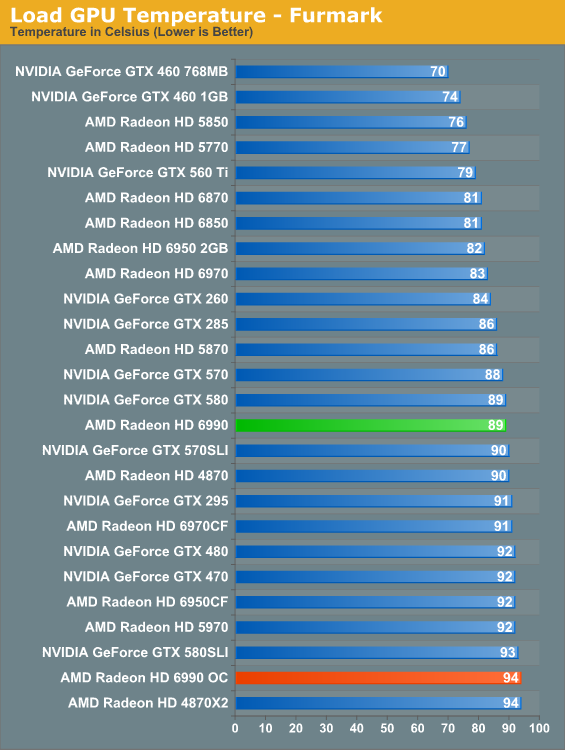
At stock clocks FurMark does not significantly change the picture. If anything it slightly improves things as PowerTune helps to keep the 6990 in the middle of the pack. Overclock however and the story changes. Without PowerTune to keep power consumption in check that 681W power consumption catches up to us in the form of 94C core temperatures. It’s only a 5C difference, but it’s as hot as we’re willing to let the 6990 get. Further overclocking on our test bed is out of the question.
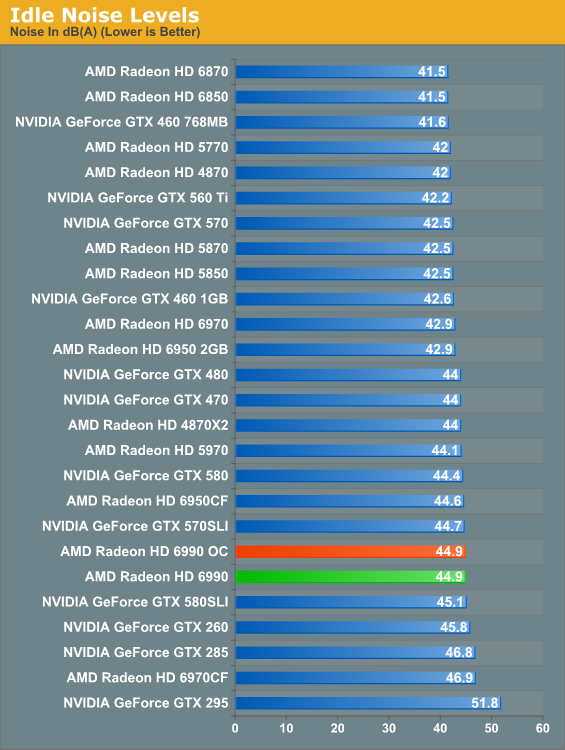
Finally there’s the matter of noise to contend with. At idle nothing is particularly surprising; the 6990 is an iota louder than the average card, presumably due to the dual-exhaust cooler.
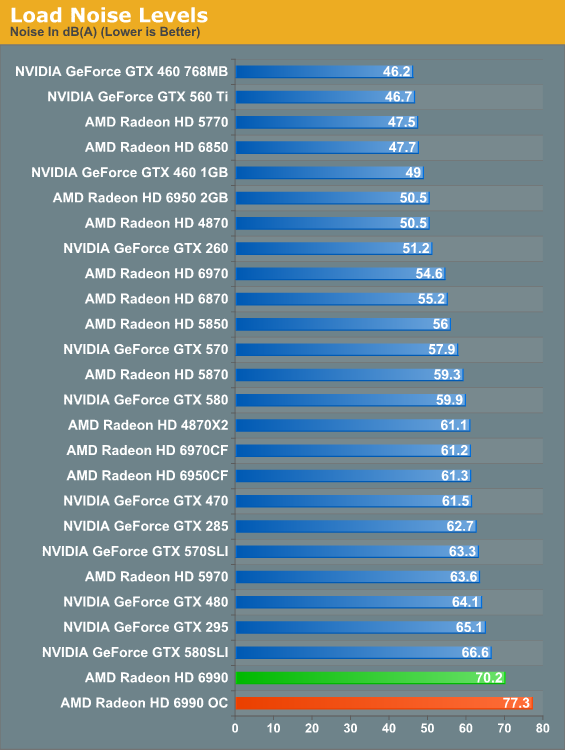
And here’s where it all catches up to us. The Radeon HD 5970 was a loud card, the GTX 580 SLI was even louder, but nothing tops the 6990. The laws of physics are a cruel master, and at some point all the smart engineering in the world won’t completely compensate for the fact that you need a lot of airflow to dissipate 375W of heat. There’s no way around the fact that the 6990 is an extremely loud card; and while games aren’t as bad as FurMark here, it’s still noticeably louder than everything else on a relative basis. Ideally the 6990 requires good airflow and good noise isolation, but the former makes the latter difficult to achieve. Water cooled 6990s will be worth their weight in gold.










130 Comments
View All Comments
EmmetBrown - Tuesday, March 8, 2011 - link
Nice, but what about the Radeon HD 6450, 6570 and 6670?http://en.wikipedia.org/wiki/Comparison_of_ATI_Gra...
Why they are available for OEM only? They looks interesting, especially the 6670, which with its 480 SP should be faster than the 5670 which has 400 SP and lower frequency. Do you plan to review them?
Ryan Smith - Tuesday, March 8, 2011 - link
As you note, they're OEM only. AMD will release them to the retail market eventually, but clearly they're not in a hurry. It's unlikely we'll review them until then, as OEM cards are difficult to come by.misfit410 - Tuesday, March 8, 2011 - link
I have to ask, if you bring up the price and say that you might as well do two 6950's in SLI when this thing doubles the performance of the GTX580, I mean would it also not be the better solution than a GTX580 which is $500 while two 6950's can apparently double it for $550 being they can be found for $225 after rebates these days.Figaro56 - Tuesday, March 8, 2011 - link
You sound a little confused. You can't run ATI cards in SLI, they run in what is called crossfire (or crossfirex which is the same thing). Two 6950's don't equal GTX580 in SLI. You need two HD 6970 cards in crossfire to nearly equal two GTX580 in SLI.In my opinion, why limit your performance with 2 HD 6950 cards, why not just bye the 2 HD 6970 cards and never have to second guess if you should have or not? But... That's just me. I have a job.
silverblue - Tuesday, March 8, 2011 - link
Totally unnecessary closing comment there, considering most people here do actually have jobs. Not everyone who has a job can afford such gear as there's more important things to spend money on.Thanny - Tuesday, March 8, 2011 - link
You sound confused, too. He miswrote SLI, but you misunderstood his point entirely. He's saying that two 6950's are significantly faster than a single 580 for almost the same price.Loiosh - Tuesday, March 8, 2011 - link
Hey guys, you forgot one other usage case that would necessitate this card: ATI+physx setup: http://www.shackpics.com/viewer.x?file=DumbVideoca...I'm currently running one and it requires a dual-GPU card. :/
In my case I'm waiting for a watercooled version. BTW, you didn't say the release date for this?
nanajuuyon - Wednesday, March 9, 2011 - link
Funny after reading this review I went into town (Tokyo) to buy a new hard disk and saw this card for sale. So in Japan at least it is already on the market..... price was ridiculous though, 79,000YEN or $945 US..... I'm sure it will be available everywhere soon.Waterblocks on the other hand could be a couple month or so away I guess...
Vinas - Tuesday, March 8, 2011 - link
If you buy this you better have it on water. 'nuff said about all this tri slot cooler talk.JPForums - Tuesday, March 8, 2011 - link
First off, nice article Ryan.Good data, relevant commentaries on said data, and conclusions.
You mention in the article that you believe some of the shortcomings of the 6990 to be a lack of PCIe bandwidth. This got me thinking that perhaps it is a good time to revisit the effect of PCIe bandwidth on modern cards. Given the P67 only natively supports 16 lanes, I'm curious to see what effect it has on CF/SLI. It could make big difference in the recommended hardware for various levels of gaming systems.
Typically, someone looking for a CF/SLI setup will get a board that supports more lanes. However, I have seen a situation where a friend built a budget i5 system and about 4 months later was in a position to acquire an HD5970 on the cheap (relatively speaking). Clearly, two HD5850s/HD5870s would have been an option.
If newer cards are effectively PCIe bandwidth limited, then a 6990 may perform more closely to an HD6970 CF setup in such a system than it does in these graphs. This would be even more of a consideration at the high end if the rare boards with support for 4x8 lane (spaced) PCIe give you no real benefit over a more common 2x16 lane board (comparing 4 HD6970s to 2 HD6990s).